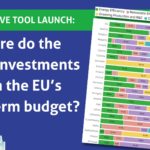The Paris Agreement Compatible (PAC) scenario describes how the EU could achieve 65% greenhouse gas emission reductions by 2030 on a pathway towards a fully renewable energy system that achieves net zero emissions in the year 2040. It’s a science-based vision of how Europe’s energy landscape should look like in line with the Paris Agreement and the 1.5°C threshold.
Climate Action Network (CAN) Europe and the European Environmental Bureau (EEB) co-drafted the first PAC Scenario and along with the Renewables Grid Initiative and REN21, they form the consortium for the PAC project. The PAC Scenario was developed from November 2018 to June 2020 under the first phase of the PAC project.
Following CAN Europe members’ request, we are in the process of updating the existing aggregated PAC scenario for the EU28 from 2020 and this will be disaggregated to get fully fledged country-specific PAC scenarios for EU member states. These scenarios can be used to challenge for more ambition in the revision processes of National Climate and Energy Scenarios (NECP). The second phase of the PAC Scenario will also examine how much implementing the scenarios would cost and will derive the macro-economic indicators for each EU and country-specific level scenario. The second phase will also examine the energy infrastructure needs related to the rolling out of the PAC scenario.
The second phase of the PAC project started in September 2021 and runs until August 2024. CAN Europe is responsible for a new PAC scenario 2.0 modelling and the modelling exercise will be implemented by a team of professional modellers from the consultancy CLIMACT, guided by the key assumptions agreed during the first phase of the PAC project. That will allow us to smoothly update our vision and understanding without reinventing the wheel.
Below is the current timeline for the PAC Scenario building:
- CLIMACT aims to hand over first country-specific draft scenarios by autumn 2022 in order to launch a first feedback round with CAN Europe members and experts, based on CLIMACT’s web-based tool, the Pathways Explorer.
- By early 2023, national member organisations ideally should be able to present their country- specific PAC scenario, in particular to influence the update of their NECPs.
- By spring 2023, macro-economic indicators will be derived.
- By autumn 2023, we will further assess the infrastructure needs (electricity grids, gas pipelines, hydrogen networks, district heat networks). For this purpose, CLIMACT will use the PyPSA model to detail and optimise the EU-level and the country-specific PAC scenarios.
Similar to the first phase, members, partners and like-minded guests will have the opportunity in the second phase of the PAC Scenario building through a series of workshops that will be held on the development of the EU and country-specific scenarios. There will also be a series of bilateral national calls where the CAN Europe secretariat will guide national member organisations through the data collection and modelling. In addition, CAN Europe launched an advisory committee to gather academia and experts to ensure a robust scientific peer review and discuss methodological challenges. Members will be updated on the progress of the PAC Scenario building during the weekly Renewable Energy Working Group meetings of CAN Europe.
For more information on the PAC Scenario 2.0, please click on the FAQ sheet below:



